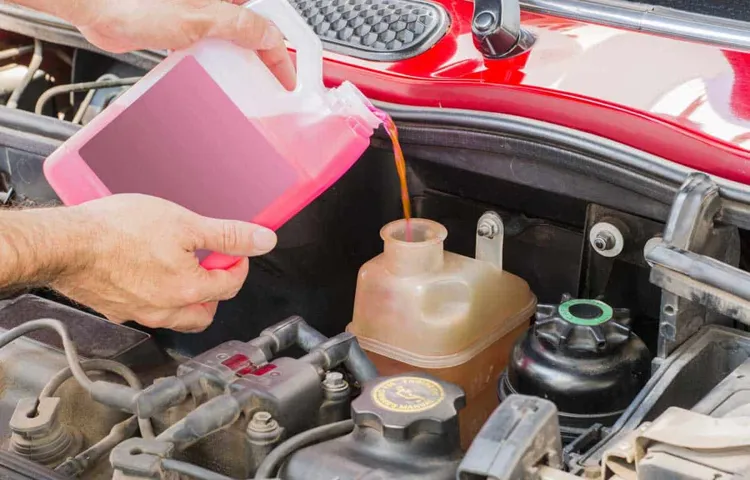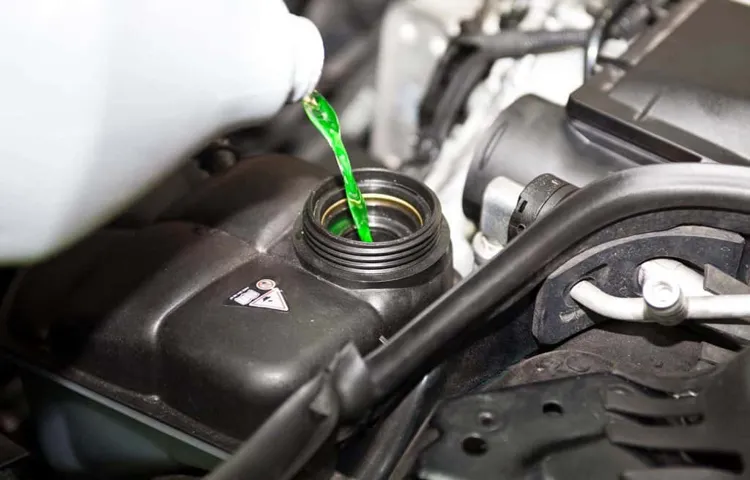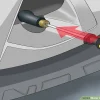Does your car seem to be running a little hotter than usual? Perhaps it’s time to check your antifreeze coolant levels. Antifreeze coolant is extremely important for your vehicle’s performance, acting as a heat transfer agent and preventing your engine from overheating. Without it, your car’s engine could be at risk of damage or even complete failure.
In this blog, we’ll discuss everything you need to know about adding antifreeze coolant to your car, including why it’s important, the steps involved, and some tips to ensure you’re doing it safely and correctly. Whether you’re a seasoned car enthusiast or a new driver, keeping your car’s antifreeze coolant levels topped off is an essential task for ensuring your vehicle runs smoothly and keeps you on the road.
Table of Contents
Gather Your Materials
If you want to add antifreeze coolant to your car, the first thing you need to do is gather your materials. You will need the coolant itself, which can often be found at your local auto parts store or hardware store. Be sure to check your owner’s manual to ensure that you are purchasing the correct type of coolant for your vehicle.
You will also need a funnel to help you pour the coolant into your car’s radiator. Additionally, you will need a rag or towel to clean up any spills or messes that may occur during the process. Once you have all of your materials together, you’ll be ready to start adding the coolant to your car.
Remember to take your time and follow all instructions carefully to ensure that your engine stays cool and functional. Using the right type and amount of antifreeze coolant can help prevent engine damage and keep your car running smoothly in both hot and cold temperatures.
Antifreeze Coolant
When it comes to checking and topping up your vehicle’s antifreeze coolant, it’s important to gather the right materials before getting started. First and foremost, you’ll need some protective gear, such as gloves and safety glasses, to protect yourself from spills or splashes. Next, grab a clean funnel and a container of antifreeze coolant that matches your vehicle’s manufacturer specifications, which you can find in the owner’s manual.
It’s also a good idea to have a rag or paper towels on hand to wipe up any excess spills or leaks. Depending on the type of vehicle you have, you may need to access the coolant reservoir through the engine bay or the radiator. Before opening the reservoir, be sure to let the engine cool down for a sufficient amount of time to prevent burns or injury.
Once you’ve gathered all of these materials, you’ll be ready to proceed with checking and topping up your antifreeze coolant to ensure your vehicle’s optimal performance and efficiency.

Funnel
When it comes to creating a successful funnel, gathering your materials is key. There are a few essential things you’ll need to have on hand in order to build an effective funnel that converts leads into customers. Firstly, you’ll need a strong lead magnet that will attract potential customers to your site.
This could be anything from a free ebook to a discount code. Additionally, you’ll need a landing page that clearly explains the value of your offer and encourages visitors to take action. To keep track of your leads as they move through your funnel, you’ll need a reliable CRM system.
And finally, you’ll need to have a series of follow-up emails that continue to provide value and build trust with your prospects. By gathering these materials, you’ll be well on your way to creating a funnel that will turn visitors into satisfied customers.
Gloves
When it comes to making gloves, having the right materials is crucial. Before you start the process, gather all of the materials you need so that you have everything on hand. You’ll need leather or another sturdy material for the glove itself, as well as a strong thread to stitch it together.
For lining, you can use a thin cotton or fleece material to keep your hands warm. If you plan on adding decorative elements to your gloves, such as buttons or embroidery, make sure you have those items on hand as well. And don’t forget about tools, such as scissors, a ruler, and a sewing machine or needle.
With all of your materials ready, you’ll be able to create a stylish and functional pair of gloves that will keep your hands warm and protect them from the elements.
Preparing Your Car for Coolant
Adding antifreeze coolant to your car is an essential maintenance task that can help prevent engine damage, especially during the winter months. To prepare your car for coolant, start by checking the coolant level in the reservoir tank and adding more coolant as needed. It’s important to use the correct type of coolant for your car’s make and model, so be sure to consult your owner’s manual or talk to a mechanic if you’re unsure.
Once you’ve added the coolant, make sure to check for any leaks or other issues that could affect your car’s performance. A good rule of thumb is to replace your coolant every two to three years, or as recommended by your car’s manufacturer. By taking the time to prepare your car’s coolant system, you’ll be better equipped to keep your engine running smoothly and avoid costly repairs down the road.
Turn off the Engine
When preparing your car for coolant, there are a few important steps to follow to ensure that your vehicle is in good shape and ready to go. First and foremost, it’s essential to turn off the engine before beginning any work. This will help prevent any accidents or injuries from occurring as you work on your car.
Additionally, turning off the engine can prevent any damage to the engine itself, which could occur if you were to work on the car while the engine is still running. It’s also a good idea to wait a few minutes before beginning any work, to allow the engine to cool down. This will help prevent any burns or injuries that could occur if you were to accidentally touch a hot engine or radiator.
By taking the time to properly prepare your car for coolant, you can help ensure that your vehicle stays in good working order for years to come.
Locate the Radiator Cap
If you’re preparing your car for coolant, finding the radiator cap is a crucial step. It’s usually located at the front of the engine compartment, just above the radiator. The cap is typically silver and often has a warning label on it, reminding you that it should only be removed when the engine is cool.
The radiator cap plays a vital role in regulating the pressure in the radiator system and preventing overheating. It’s important to make sure the cap is tightly secured to avoid coolant leaks and ensure your engine stays cool. If you’re having trouble locating the cap, refer to your car owner’s manual for guidance.
Remember to always follow safety precautions, such as allowing the engine to cool down before opening the cap. With the right knowledge and care, you can effectively prepare your car for coolant and keep it running smoothly.
Remove the Radiator Cap
When it comes to preparing your car for coolant, removing the radiator cap is an important step. Before you get started, it’s essential that your engine has completely cooled down to avoid any mishaps. Once you’re sure that your engine is safe to work with, you can locate the radiator cap at the top of the radiator.
To remove it, use a cloth or rag to cover the cap to protect your hands from the hot steam that could escape. Then, twist the cap counterclockwise and lift it off. Be cautious of any residual steam, and keep a safe distance from the radiator while it cools down.
By removing the radiator cap, you’re allowing any excess pressure to escape, which is crucial when adding or changing coolant. With proper care and attention, you can ensure that your car’s cooling system will perform smoothly and efficiently, giving you peace of mind when you hit the road.
Adding Coolant to Your Car
If you’ve noticed that your car’s temperature gauge is rising unusually high, it could be because your coolant levels are low. Adding antifreeze coolant to your car is a simple task that can be done fairly easily. First, make sure that your engine has cooled down completely before opening the hood.
The coolant reservoir is typically located near the front of the engine compartment and is marked with either “coolant” or “antifreeze.” Check the fluid levels in the reservoir and add coolant if necessary. It’s important to use the correct mixture of coolant and water as recommended by your car’s manufacturer.
If the coolant level keeps dropping, it’s important to check for leaks in your engine. Remember to never open a radiator cap if the engine is still hot as this can cause serious injuries. By following these simple steps, you can keep your car running smoothly and prevent overheating.
Insert the Funnel into the Radiator
Adding coolant to your car is an important task that should be performed regularly to ensure the safe and efficient operation of your engine. One crucial step of this process is inserting the funnel into the radiator, which helps to prevent spills and makes pouring in the coolant easier. When choosing your funnel, be sure to select one that is narrow enough to fit into the radiator opening and long enough to reach the bottom.
Once you have selected your funnel, carefully insert it into the radiator and make sure that it is securely in place. Then, slowly pour the coolant into the funnel, taking care not to overfill the radiator. It is important to use the correct type of coolant for your car, as different types have different properties and may not be compatible with your engine.
By following these simple steps, you can add coolant to your car safely and efficiently, helping to prevent overheating and other engine problems.
Pour the Antifreeze Coolant
Adding coolant to your car is an essential part of maintaining its health and longevity. When the weather gets colder, it’s crucial to flush the old coolant and pour in fresh antifreeze. It’s important to have the correct mixture of antifreeze and water, typically a 50/50 ratio, to ensure optimal performance.
To pour the antifreeze coolant, first, locate the coolant reservoir or radiator cap, depending on your car’s make and model. Remove the cap and slowly pour in the coolant mixture until it reaches the full line. Be careful not to overfill or spill the coolant.
Once you’re done, replace the cap tightly and discard any leftover coolant properly. Regularly adding coolant to your car will keep it running at its best and protect against damage from extreme temperatures. So, don’t neglect this essential maintenance step, and your car will thank you for it.
Replace and Tighten the Radiator Cap
Adding coolant to your car is an essential maintenance task that ensures your engine runs cool and efficiently. The first step is to locate the radiator cap, usually located near the front of the engine compartment and marked with a warning label. Once you’ve found it, make sure the engine is off and cool before opening the cap.
Always use a rag or gloves to protect your hands from hot steam or coolant. Slowly twist the cap counterclockwise to release pressure, then remove it completely. Next, fill the radiator with the recommended coolant mixture until it reaches the “full” line.
Make sure to replace and tighten the cap securely to avoid leaks. It’s important to check the coolant level regularly and refill as needed, particularly during hot weather or when driving in stop-and-go traffic. Neglecting the coolant system can lead to engine overheating and costly repairs, so stay on top of your car’s cooling needs!
Checking the Coolant Level
If you want your car to run smoothly and efficiently, it’s important to make sure that the coolant level is topped up. To do this, you’ll need to know how to add antifreeze coolant to your car. First, locate the coolant reservoir in your engine bay.
It’s usually a translucent container with a cap that’s marked with either “Coolant” or “Engine Coolant.” Make sure your engine is cool before opening the cap, as the coolant system can get very hot. Check the coolant level, which should be between the “low” and “high” marks.
If it’s low, add enough antifreeze coolant until it reaches the “high” mark. Be careful not to overfill, as this can cause damage to your vehicle. Remember that the type of coolant you use matters, too, so make sure to read your car manual for specific recommendations.
With a properly filled coolant reservoir, you can rest assured that your car is ready for any journey.
Check the Coolant Reservoir
Checking the coolant level is an essential part of maintaining your car’s engine. One of the easiest ways to check the coolant level is by inspecting the coolant reservoir. The coolant reservoir is a small plastic container located near the radiator of your car.
It has maximum and minimum markings, indicating the correct level of coolant. To ensure that the coolant is at the correct level, start by checking the markings on the reservoir. If the coolant level is below the minimum marking, it’s important to add the correct type of coolant.
The type of coolant is usually indicated on the cap of the reservoir. Pour the coolant slowly into the reservoir until it reaches the maximum marking. After pouring, replace the cap and run the engine for a few minutes to allow the coolant to circulate.
Checking the coolant reservoir regularly can prevent engine overheating and other expensive car repairs. So, next time you pop the hood, take a quick look at the coolant reservoir. It could save you a costly trip to the mechanic!
Fill the Reservoir if Necessary
Checking the coolant level in your car is essential to ensuring that your engine doesn’t overheat. It’s a simple task that you can do yourself with a few easy steps. First, make sure that your car has been turned off for a while and the engine is cold.
Otherwise, there could be hot pressurized coolant that could escape and potentially cause burns. Next, locate the coolant reservoir, which is usually translucent and located near the engine. Make sure that the level of coolant is between the minimum and maximum lines indicated on the reservoir.
If it’s below the minimum line, fill it up with a coolant mixture that’s recommended for your car. Make sure not to overfill it, however, as this could cause leaks or other issues. If you’re not sure how to do this, consult your car’s manual or take it to a professional.
Remember, an overheated engine can cause costly damage, so it’s always better to be safe than sorry.
Conclusion
In conclusion, adding antifreeze coolant to your car is as easy as a few simple steps. Just remember: never mix different types or colors of coolant, make sure your engine is cool before adding, and always use the proper ratio of coolant to water. Adding antifreeze is like giving your car a cozy blanket for the winter, ensuring smooth driving and avoiding any icy surprises on your morning commute.
So, grab your favorite hot beverage, put on your biggest smile, and give your car the love and care it deserves. Happy driving, and may all your roads be clear and smooth!”
FAQs
What is antifreeze coolant and why is it important for a car?
Antifreeze coolant is a liquid substance that is added to a car’s cooling system to lower the freezing point and raise the boiling point of the water it contains. This ensures that the engine stays at a safe operating temperature in all conditions and prevents damage from overheating or freezing.
How often should I check and refill the antifreeze coolant in my car?
It is recommended to check the coolant level and condition every 3 months or 3,000 miles, and to refill or replace it every 2 years or 24,000 miles. However, this may vary depending on the make and model of your car, so it’s best to consult your owner’s manual or a trusted mechanic for specific guidelines.
Can I use any type of antifreeze coolant in my car?
No, you should always check your owner’s manual or consult with a professional to determine the specific type and brand of coolant recommended for your car. Using the wrong type or mixing different types can cause damage to your engine or cooling system.
What are the signs that my car’s antifreeze coolant needs to be replaced?
Some common signs of low or contaminated coolant include: overheating, low coolant warning light, strange smells coming from the engine, leaks or puddles under the car, and a sweet or burnt odor from the exhaust.
Can I add antifreeze coolant to my car myself, or should I take it to a mechanic?
You can add coolant to your car yourself, but it’s important to follow the correct procedure and safety guidelines. This may involve waiting until the engine has cooled down, finding the correct coolant mixture, locating the coolant reservoir, and using a funnel to pour the liquid in slowly. If you are unsure or uncomfortable with this process, it’s always best to seek the help of a professional.
What happens if I don’t have enough antifreeze coolant in my car?
If your car’s cooling system doesn’t have enough coolant, the engine can overheat and cause damage or even engine failure. This can also lead to leaks, corrosion, and other costly repairs.
How can I prevent problems with my car’s antifreeze coolant?
You can prevent many coolant-related issues by keeping up with your car’s regular maintenance schedule, checking the coolant level and condition regularly, using the recommended coolant type and brand, avoiding mixing different types of coolant, and addressing any issues or leaks promptly.



